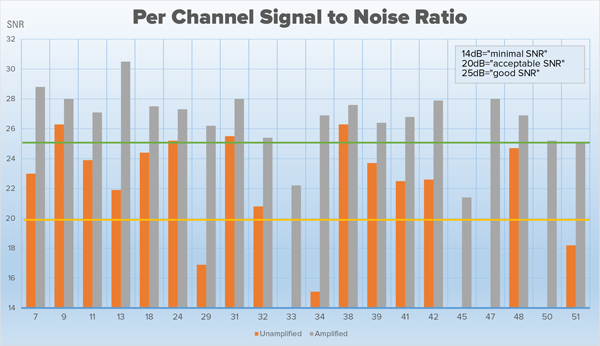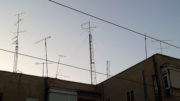It’s a big controversy.Ever since television in the US went to digital, there has been a real question as to whether or not people actually need antenna amplifiers, or if they are just a big waste of time. There are two reasons for this:
1. Digital signals just respond differently to amplifiers.
Even though digital signals are carried on an analog subcarrier (remember, in life, nothing is really digital) they still act like digital signals. When you amplify an analog signal, there’s a chance you’ll get details you didn’t see before. It’s like zooming in on a real, film-based photograph. Sometimes there’s stuff there you just couldn’t get.
However, digital signals are only ones and zeroes. If you can tell that there is a one or a zero, that’s all you need. Making it a bigger one or zero isn’t going to tell you anything. That’s why digital signals are actually better for broadcasting in most cases.
2. Because with digital signals it’s all about noise.
As I wrote in a previous article, signal power isn’t the most important way to measure digital signals. The only thing that really matters is how much stronger the signal is than the noise around it. Sure, signal power has something to do with that, but just amplifying a signal for the sake of higher numbers isn’t going to help, and in some cases it can actually hurt you.
Still, there has always been a question about using amplifiers in “fringe areas,” where signals are very weak. Since an amplifier also amplifies the noise that’s all around, is it worth using an amp in this case? Luckily I was able to do some fairly detailed testing using a decent scientific method.
The setup
Testing took place at our Southern California lab, about 60 miles from the broadcast towers. The unique geography of Southern California means signals travel further; broadcast towers are at 5,500 feet elevation and the entire area is like a big bowl, getting higher up as it gets further from the towers. That, and the stable air that creates a smog layer that bounces signals back to earth, make for the perfect reception environment. At 60 miles, reception would be impossible in some areas but in Southern California, a roof-mounted antenna usually does pretty well.
I set up a Televes antenna at 6 feet above ground level and aimed it for maximum signal. This antenna was chosen because it should be a real struggle to pull in signal with a smaller antenna like this, and because it has passive amplification which meant that in order to test unamplified performance, all I had to do was unplug it.
All tests were conducted within the same half-hour period. Signal strength and signal-to-noise ratio was measured with a Televes H45 signal meter. This meter is my “old reliable.” I’ve been using it for about six years and I know what it can do.
Unamplified performance was measured by unplugging the power inserter, then amplified performance was measured after plugging in the power. No other changes were made to the test rig while measurements took place. Weather remained stable during testing.
Measurements were done at the antenna with a total of 10 feet of RG6 cable.
The Televes H45 meter reads signal strength and signal-to-noise ratio at the same time, so all measurements per channel were done concurrently.
Signal Strength
The first set of measurements compares signal strength in unamplified and amplified situations. In general, signals under 35dBμV are not considered usable. Those levels are shaded grey in the chart.

In the chart you can see that four channels that couldn’t be received at all are present (33,45,47,50), and three channels that were either marginal or below the threshold (29,32,34,51) now have really good strength.
So if we look at this chart we would think that we could now get 20 channels instead of 12, just by adding an amplifier. That sounds pretty good! The problem is, that doesn’t tell us the whole story.
Signal-to-Noise Ratio
In this chart, we consider 14dB to be the minimal SNR (signal-to-noise ratio) that is acceptable under any circumstances. 20dB means we could safely add a 1×4 splitter, and 25dB is considered good enough that storms, long runs, and the like aren’t a problem.

Here we really begin to see the whole picture. Let’s compare the number of channels (amped vs. unamped) at three different levels:
| Unamplified | Amplified | |
| 14dB | 16 | 20 |
| 20dB | 14 | 20 |
| 25dB | 3 | 15 |
So in a perfect world we might get 16 channels without the amp or 20 with. However, that begins to really fall off as we raise the stakes. By the time we get to 25dB, which is the level you would need to have good signal to 4 TVs and use 100 feet of cable, only 15 of those channels come in with an amplifier… compared to 3 without one!
This is really important if you were counting on getting channels 32, 33, 45, 50, or 51. Plain signal strength numbers would convince you that they would come in, but with SNR at or below the number you need, they would go in and out.
So does an amplifier help?
In this case, an amplifier absolutely does help pull in more signals, because the towers are so far away that adding more signal helps defeat the noise. That’s why an amplifier can help in fringe situations like this.
However, if we were closer to the towers, say 15 miles away, we could have seen that all our channels had high SNR, so an amplifier wouldn’t have done anything at all for us. Or, if we were so far away that most of our channels didn’t even tune in, that would mean there was so much noise that amplifying was never going to give you anything.
The bottom line here is that amplifiers don’t always solve problems. In a very specific case like this one, they can, but you have to use some sophisticated equipment to know exactly what you’re likely to get. In general, amplifiers do their best work in fringe areas and with long cable runs. They aren’t a fix-all solution, but they sometimes help in surprising ways.
Need an amplifier?
We’re here for it! Shop the great selection at Solid Signal, or get advice from an expert! Call 888-233-7563 and you’ll reach a qualified antenna technician in our Michigan corporate offices. If it’s after hours, fill out the form below and we’ll get right back to you!





